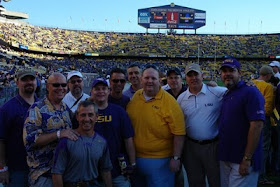
Recently, at the start of this school year, the LSU Athletic Training Program installed a brand new Fuji FCR Prima, a Digital X-Ray Processor to replace the outdated X-Ray films. According to Andy Barker, MS, ATC, Senior Associate Athletic Trainer for Football, the digital X-Ray processor was installed for several reasons:
- Do not have to purchase x-ray film
- Do not have to purchase chemicals needed to process the film
- No need for excess storage of films
- Can burn x-rays to a CD, allowing student-athlete to have a copy
- Can e-mail x-ray to an iPad for Team Physicians to have easier and more efficient access to the x-ray
- Compact and light features
Only one disadvantage was noted in the digital x-ray processor, and that was the inability to pull up past x-rays taken on the old, traditional x-ray machine. This means that past x-ray films will still be stored in the Athletic Training Room.
The Fuji FCR (Computed Radiography) Prima is a digital x-ray processor designed specifically for use by small, low-volume private practices that only perform about 5-15 studies per day.
So what are some other advantages of Digital X-Ray Processors versus the traditional radiographic techniques?
According to Ward, et al., traditional radiographic techniques, although easy to perform and widely available, lack precision in skeletal assessment. The main source of imprecision was the difficulty to measure the width of cortical bone and estimate the exact points of major regions of the bone (Ward, et al., 2003). However, Digital X-Ray Radiogammetry (DXR) uses the principles of traditional radiography in addition to added techniques which increase the precision needed to identify skeletal abnormalities. DXR uses image processing to reduce errors from estimation of bone landmarks by automating exact location of regions needed for analysis. "Automated computer vision techniques will always be more reproducible than those dependent on human decisions and actions, explaining why DXR has improved precision in comparison with previous methods of radiogammetry" (Ward, et al., 2003). The biggest advantage of DXR in Athletic Training settings is the ability to take the radiograph in one location, and almost immediately access the same radiograph from remote settings connected to the network. This portability and easy access to X-Rays is particularly important in the collegiate setting, where on-site access to physicians is not always possible.
"The practice of digital radiographic imaging if poised to undergo dramatic change in the very near future owing to a rapid proliferation of electronically readable x-ray detectors" (Chotas, et al., 1999). In conclusion, there are two main reasons why digital radiogammetry is becoming more popular in health care settings: promise of very rapid access to digital images wherever radiography with stationary X-Ray equipment is performed and the anticipation of image quality that exceeds that of traditional radiographic systems because of improvements in X-Ray detector technology (Chotas, et al., 1999).
ReferencesWard, KA, Cotton, J, & Adams, JE. (2003). A technical and clinical evaluation of digital x-ray radiogammetry,
Osteoporos Int, 14. Retrieved from: http://www.springerlink.com/content/x83hxk4lfu2wfepu
Chotas, HG, Dobbins, JT, & Ravin, CE. (1999). Principles of digital radiography with large-area electronically readable detectors: a review of the basics:
Radiology, 210. Retrieved from: http://radiology.rsna.com/content/210/3/595.full












